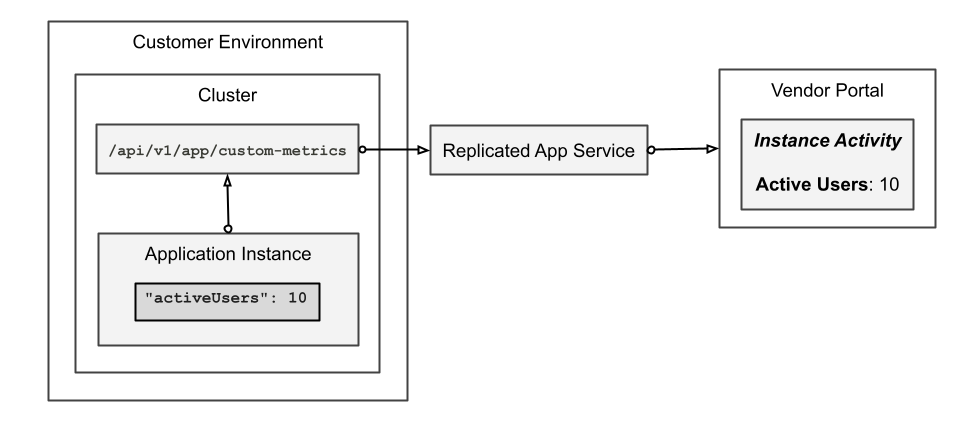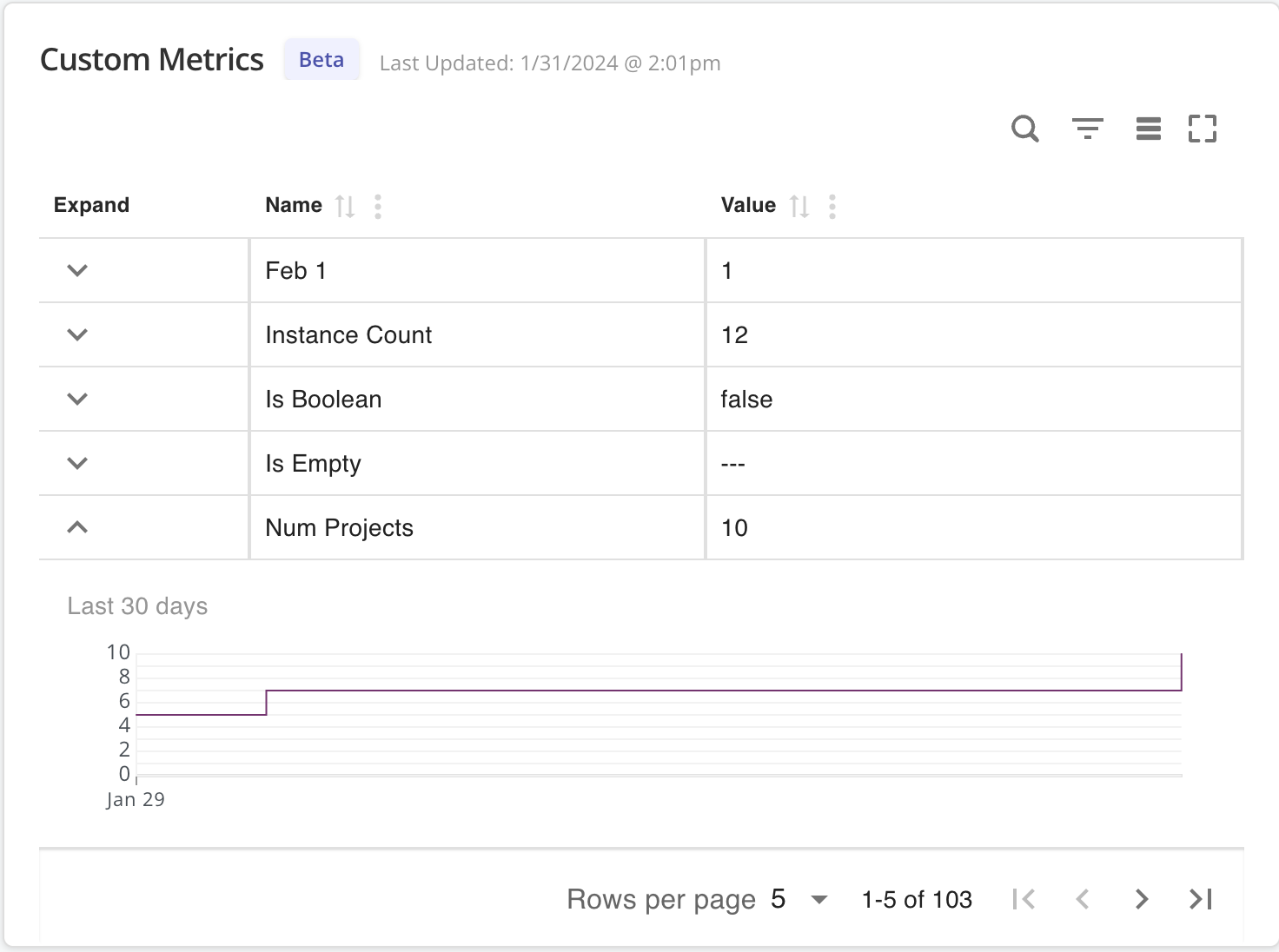Configure Custom Metrics (Beta)
This topic describes how to configure an application to send custom metrics to the Replicated Vendor Portal.
Overview
In addition to the built-in insights displayed in the Vendor Portal by default (such as uptime and time to install), you can also configure custom metrics to measure instances of your application running customer environments. Custom metrics can be collected for application instances running in online or air gap environments.
Custom metrics can be used to generate insights on customer usage and adoption of new features, which can help your team to make more informed prioritization decisions. For example:
- Decreased or plateaued usage for a customer can indicate a potential churn risk
- Increased usage for a customer can indicate the opportunity to invest in growth, co-marketing, and upsell efforts
- Low feature usage and adoption overall can indicate the need to invest in usability, discoverability, documentation, education, or in-product onboarding
- High usage volume for a customer can indicate that the customer might need help in scaling their instance infrastructure to keep up with projected usage
How the Vendor Portal Collects Custom Metrics
The Vendor Portal collects custom metrics through the Replicated SDK that is installed in the cluster alongside the application.
The SDK exposes an in-cluster API where you can configure your application to POST metric payloads. When an application instance sends data to the API, the SDK sends the data (including any custom and built-in metrics) to the Replicated app service. The app service is located at replicated.app or at your custom domain.
If any values in the metric payload are different from the current values for the instance, then a new event is generated and displayed in the Vendor Portal. For more information about how the Vendor Portal generates events, see How the Vendor Portal Generates Events and Insights in About Instance and Event Data.
The following diagram demonstrates how a custom activeUsers metric is sent to the in-cluster API and ultimately displayed in the Vendor Portal, as described above:

View a larger version of this image
Requirements
To support the collection of custom metrics in online and air gap environments, the Replicated SDK version 1.0.0-beta.12 or later must be running in the cluster alongside the application instance.
The PATCH and DELETE methods described below are available in the Replicated SDK version 1.0.0-beta.23 or later.
For more information about the Replicated SDK, see About the Replicated SDK.
If you have any customers running earlier versions of the SDK, Replicated recommends that you add logic to your application to gracefully handle a 404 from the in-cluster APIs.
Limitations
Custom metrics have the following limitations:
-
The label that is used to display metrics in the Vendor Portal cannot be customized. Metrics are sent to the Vendor Portal with the same name that is sent in the
POSTorPATCHpayload. The Vendor Portal then converts camel case to title case: for example,activeUsersis displayed as Active Users. -
The in-cluster APIs accept only JSON scalar values for metrics. Any requests containing nested objects or arrays are rejected.
-
When using the
POSTmethod any existing keys that are not included in the payload will be deleted. To create new metrics or update existing ones without sending the entire dataset, simply use thePATCHmethod.
Configure Custom Metrics
You can configure your application to POST or PATCH a set of metrics as key value pairs to the API that is running in the cluster alongside the application instance.
To remove an existing custom metric use the DELETE endpoint with the custom metric name.
The Replicated SDK provides an in-cluster API custom metrics endpoint at http://replicated:3000/api/v1/app/custom-metrics.
Example:
POST http://replicated:3000/api/v1/app/custom-metrics
{
"data": {
"num_projects": 5,
"weekly_active_users": 10
}
}
PATCH http://replicated:3000/api/v1/app/custom-metrics
{
"data": {
"num_projects": 54,
"num_error": 2
}
}
DELETE http://replicated:3000/api/v1/app/custom-metrics/num_projects
POST vs PATCH
The POST method will always replace the existing data with the most recent payload received. Any existing keys not included in the most recent payload will still be accessible in the instance events API, but they will no longer appear in the instance summary.
The PATCH method will accept partial updates or add new custom metrics if a key:value pair that does not currently exist is passed.
In most cases, simply using the PATCH method is recommended.
For example, if a component of your application sends the following via the POST method:
{
"numProjects": 5,
"activeUsers": 10,
}
Then, the component later sends the following also via the POST method:
{
"activeUsers": 10,
"usingCustomReports": false
}
The instance detail will show Active Users: 10 and Using Custom Reports: false, which represents the most recent payload received. The previously-sent numProjects value is discarded from the instance summary and is available in the instance events payload. In order to preseve numProjectsfrom the initial payload and upsert usingCustomReports and activeUsers use the PATCH method instead of POST on subsequent calls to the endpoint.
For example, if a component of your application initially sends the following via the POST method:
{
"numProjects": 5,
"activeUsers": 10,
}
Then, the component later sends the following also via the PATCH method:
{
"usingCustomReports": false
}
The instance detail will show Num Projects: 5, Active Users: 10, Using Custom Reports: false, which represents the merged and upserted payload.
NodeJS Example
The following example shows a NodeJS application that sends metrics on a weekly interval to the in-cluster API exposed by the SDK:
async function sendMetrics(db) {
const projectsQuery = "SELECT COUNT(*) as num_projects from projects";
const numProjects = (await db.getConnection().queryOne(projectsQuery)).num_projects;
const usersQuery =
"SELECT COUNT(*) as active_users from users where DATEDIFF('day', last_active, CURRENT_TIMESTAMP) < 7";
const activeUsers = (await db.getConnection().queryOne(usersQuery)).active_users;
const metrics = { data: { numProjects, activeUsers }};
const res = await fetch('https://replicated:3000/api/v1/app/custom-metrics', {
method: 'POST',
headers: {
"Content-Type": "application/json",
},
body: JSON.stringify(metrics),
});
if (res.status !== 200) {
throw new Error(`Failed to send metrics: ${res.statusText}`);
}
}
async function startMetricsLoop(db) {
const ONE_DAY_IN_MS = 1000 * 60 * 60 * 24
// send metrics once on startup
await sendMetrics(db)
.catch((e) => { console.log("error sending metrics: ", e) });
// schedule weekly metrics payload
setInterval( () => {
sendMetrics(db, licenseId)
.catch((e) => { console.log("error sending metrics: ", e) });
}, ONE_DAY_IN_MS);
}
startMetricsLoop(getDatabase());
View Custom Metrics
You can view the custom metrics that you configure for each active instance of your application on the Instance Details page in the Vendor Portal.
The following shows an example of an instance with custom metrics:

View a larger version of this image
As shown in the image above, the Custom Metrics section of the Instance Details page includes the following information:
- The timestamp when the custom metric data was last updated.
- Each custom metric that you configured, along with the most recent value for the metric.
- A time-series graph depicting the historical data trends for the selected metric.
Custom metrics are also included in the Instance activity stream of the Instance Details page. For more information, see Instance Activity in Instance Details.
Export Custom Metrics
You can use the Vendor API v3 /app/{app_id}/events endpoint to programatically access historical timeseries data containing instance level events, including any custom metrics that you have defined. For more information about the endpoint, see Export Customer and Instance Data.